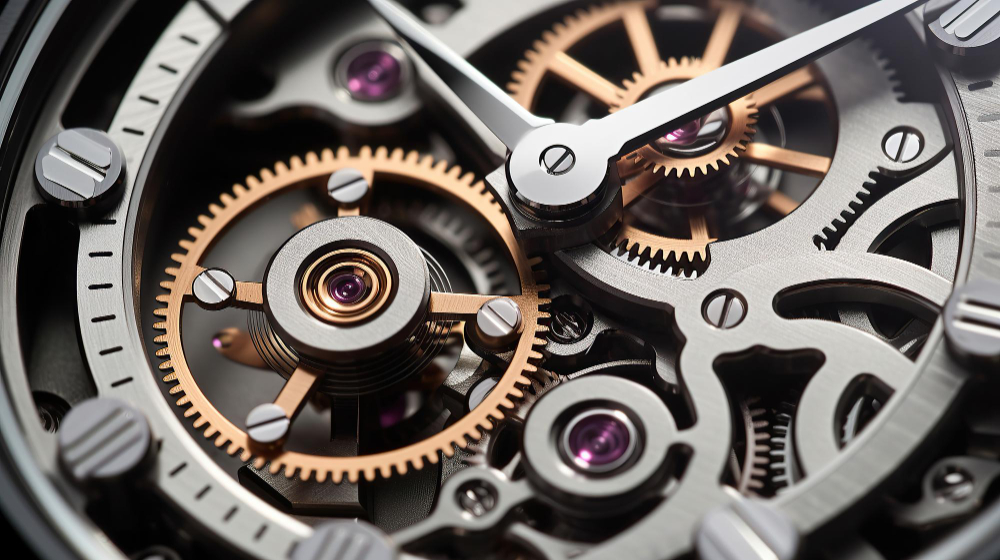In the world of horology, few innovations are as celebrated as the mechanical watch movement. This intricate mechanism is the heartbeat of luxury watches, allowing them to function with remarkable accuracy and elegance. While digital and quartz watches dominate the market due to convenience and affordability, the allure of mechanical watch movements remains unrivaled among collectors and enthusiasts. But what makes these mechanical wonders so captivating, and how do they continue to hold a special place in the world of high-end timepieces?
In this article, we will delve deep into the artistry, precision, and craftsmanship behind mechanical watch movements. We’ll explore how they work, why they remain popular, and the painstaking labor that goes into each timepiece.
Understanding the Basics of a Mechanical Watch Movement
At its core, a mechanical watch movement is a series of interconnected gears, springs, and levers that drive the watch’s hands. Unlike quartz watches, which rely on a battery, mechanical watches are powered by a tightly coiled mainspring. The mainspring stores energy and gradually releases it in a controlled way, driving power through a system of gears and escapements to regulate the passage of time.
There are two main types of mechanical watch movements:
- Manual Movement – In a manual mechanical watch, the wearer must regularly wind the mainspring by turning the crown of the watch. This provides the necessary energy to keep the timepiece running.
- Automatic Movement – An automatic or self-winding movement takes things a step further by harnessing the motion of the wearer’s wrist to wind the mainspring. As long as the watch is worn regularly, it will remain fully wound without manual intervention.
The Components of a Mechanical Watch Movement
To truly appreciate the complexity of a mechanical watch movement, it’s important to understand its key components:
- Mainspring: The mainspring is the energy source of the watch. Once wound, it gradually unwinds, releasing stored energy to power the movement.
- Gear Train: The gear train transmits energy from the mainspring to the escapement and ultimately to the hands of the watch. Each gear has a specific ratio to ensure accurate timekeeping.
- Escapement: This is the part of the movement that regulates the release of energy. It controls how fast the gears turn and ensures the watch ticks at a steady pace.
- Balance Wheel: Similar to a pendulum in a clock, the balance wheel oscillates back and forth, controlling the rate at which the escapement releases energy.
- Jewels: Synthetic rubies are used to reduce friction in the movement’s high-stress areas. These “jewels” help ensure the watch operates smoothly and lasts for decades without excessive wear.
- Hands: The gear train drives the hour, minute, and second hands, translating the movement’s internal mechanics into a visual representation of time.
Each of these components must be meticulously crafted and assembled to ensure that the watch functions accurately and reliably. Even the tiniest imperfections can result in a watch losing or gaining several minutes per day.
The Art of Watchmaking: A Legacy of Craftsmanship
Creating a high-quality mechanical watch movement is no small feat. It requires immense skill, precision, and patience, honed over years of practice. Many watchmakers spend decades mastering their craft, learning how to fine-tune tiny components and assemble them by hand.
The process begins with the design and production of the movement’s individual parts. While modern technology has improved the manufacturing process, many luxury brands still produce components in-house, ensuring that each part meets their exacting standards. Watchmakers must carefully cut, polish, and finish each piece before assembling them into the final product.
One of the key elements of high-end watchmaking is decoration. Mechanical watch movements often feature intricate patterns and engravings, such as Côtes de Genève (Geneva stripes) or perlage (circular graining). While these decorations don’t impact the functionality of the watch, they are a testament to the craftsmanship and attention to detail that goes into each timepiece.
Brands like Patek Philippe, Audemars Piguet, and Vacheron Constantin are renowned for their stunning movement designs; often incorporating sapphire crystal case backs so that wearers can admire the beauty of the mechanics in motion.
Why Choose a Mechanical Watch Movement?
With the advent of quartz and digital watches, why do mechanical watches still hold such prestige in the world of horology? The answer lies in the combination of craftsmanship, tradition, and timeless appeal.
- Artistry: Unlike mass-produced quartz watches, each mechanical movement is a work of art. The painstaking assembly and intricate detailing make every timepiece a unique creation, elevating it from a simple tool to a wearable masterpiece.
- Longevity: A well-maintained mechanical watch movement can last a lifetime, or even longer. With regular servicing, many vintage watches are still in perfect working order today, passing through generations as heirlooms.
- Tradition: Mechanical watches represent a continuation of centuries-old horological traditions. They embody the skills and techniques of master watchmakers who have passed their knowledge down through generations.
- Investment Value: Mechanical watches, especially from prestigious brands, often appreciate in value over time. Collectors and enthusiasts are willing to pay a premium for these timepieces, making them a sound investment for the future.
- Connection: Many people feel a deeper connection to mechanical watches because of the craftsmanship involved. The act of winding a watch, hearing the ticking, and knowing that a tiny engine of gears and springs is keeping time creates a sense of nostalgia and reverence.
The Future of Mechanical Watch Movements
In an increasingly digital world, mechanical watch movements continue to thrive. Luxury brands are pushing the boundaries of horological innovation, incorporating new materials like silicon to improve accuracy and longevity. Companies like Omega have developed Co-Axial escapements, which require less lubrication and are more durable over time.
While technology will undoubtedly continue to evolve, there will always be a market for mechanical watches. These timepieces offer a unique blend of history, engineering, and artistry that cannot be replicated by digital alternatives.
Conclusion
The mechanical watch movement is more than just a method of telling time—it’s a masterpiece of engineering, craftsmanship, and tradition. For centuries, watchmakers have been perfecting these intricate mechanisms, creating timeless pieces that are as beautiful as they are functional.
Whether you’re a seasoned watch collector or a newcomer to the world of horology, the allure of a finely crafted mechanical watch is undeniable. It serves as a reminder that even in a world dominated by technology, there is still room for the artistry and precision of a mechanical timepiece to capture the imagination.
By focusing on the artistry, longevity, and timeless appeal of mechanical watch movements, you can enjoy a piece of history on your wrist—one that will continue to tick for generations to come.



